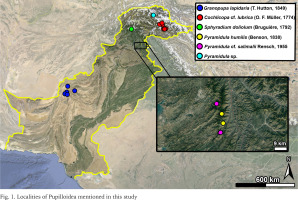INTRODUCTION
Land snail surveys were conducted by the first author throughout much of Pakistan during 1990–1992; the Pupilloidea being the most commonly encountered group. The pupilloid fauna of Pakistan is remarkably diverse with a broad influence from the Palearctic/Holarctic, particularly at the genus level. Pokryszko et al. (2009) reviewed the Truncatellininae Steenberg, 1925, Vertigininae Pilsbry, 1918, Gastrocoptinae Pilsbry, 1918, and Pupillinae Turton, 1831 (in part), providing morphological and distributional data for 22 species, including descriptions of ten new species. A review of diverse Enidae Woodward, 1903 (1880) will be published in the near future. Toward completion of the review of Pakistan Pupilloidea, Chondrinidae Steenberg, 1925, Cochlicopidae Pilsbry, 1900 (1897), Orculidae Pilsbry, 1918, and Pyramidulidae Kennard et Woodward, 1914 are discussed here.
METHODS AND MATERIALS
In addition to the specimens collected by the first author in the early 1990s, the late Walter Auffenberg (Florida Museum of Natural History), Hafeez Rehman, Aleem Khan, and Shamim Fakhri (Zoological Survey of Pakistan) provided additional specimens.
The political unit, district is not generally used in collection sites because districts are relatively often divided and renamed due to human population growth. Collection sites are listed as given on the specimen labels, including spellings that are no longer recognised, i.e. Baluchistan is now Balochistan.
About 340 specimens from an estimated 20 localities were examined during this study (Fig. 1). Specimens were collected by hand and/or the taking of soil or leaf litter samples at virtually every locality. The soil and leaf litter samples were later sorted under standard stereo microscopes. All specimens are housed in the Malacology and Invertebrate Zoology collection of the Florida Museum of Natural History, University of Florida, Gainesville. Basic shell measurements and whorl counts follow those of Kerney et al. (1983: 21). All measurements are given in millimeters (mm).
Photographs were taken using a Nikon SMZ25 digital microscope with Nikon Nis-Elements software.
The following abbreviations are used in the text and figures: FANA – Federally Administered Tribal Areas; former name for modern-day Gilgit-Baltistan and seven newly merged tribal districts of Khyber Pakhtunkhwa Province; H – shell height; NHM, NHMUK – The Natural History Museum, London; UF – Florida Museum of Natural History, University of Florida; UMZC – University of Cambridge Museum of Zoology; W – shell width.
SYSTEMATICS
Chondrinidae Steenberg, 1925
Granariinae Kokshoorn & Gittenberger, 2010
Genus Granopupa Boettger, 1889
Granopupa Boettger 1889: 249.
Type Species: Pupa granum Draparnaud, 1801 (by monotypy).
Distribution. Discontinuous from the Saudi Arabian Peninsula eastward to the borderlands of Pakistan and Afghanistan (Schileyko1998: 120; Gittenberger et al. 2016).
Remarks. Granopupa and Granaria Held, 1838 are remarkably similar in shell morphology, particularly the relative positions and sizes of the apertural barriers. Gittenberger (1973) discussed two groups within Granaria; a western group in Europe (G. frumentum (Draparnaud, 1801), G. variabilis (Draparnaud, 1801), G. stabilei (von Martens, 1865), and G. braunii (Rossmässler, 1842)) and an eastern group occurring from Saudi Arabia to western Pakistan (G. lapidaria, G. persica, and G. arabica). The two groups were differentiated mainly on shell size because the eastern group was known from shells only. Gittenberger et al. (2016) reexamined the groups during an analysis of recently collected material of G. persica. That study on shell morphology, anatomy, and molecular data, resulted in the eastern group being transferred to Granopupa.
Granopupa lapidaria (T. Hutton, 1849)
Figs 2–9
Chondrinidae and Cochlicopidae of Pakistan: 2–7 – Granopupa lapidaria (T. Hutton, 1849); 8–9 – Cochlicopa cf. lubrica (O. F. Müller, 1774), UF197003, specimen 1. Scale bars 1 mm. All photos: B. Páll-Gergely
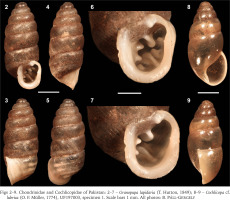
Pupa lapidaria Hutton 1849: 652–653.
Pupa lapidaria Hutton, 1849 – Pfeiffer 1853: 3, 546; Theobald 1863: 381; Hanley & Theobald 1874: 40, pl. 100, fig. 10; Sowerby 1878: 20, pl. 16, fig. 147 (not pl. 4, fig. 32, see Pilsbry 1918: 331).
Pupa (Torquilla) lapidaria (Hutton, 1849) – Adams & Adams 1855: 169.
Abida (?) lapidaria (Hutton, 1849) – Pilsbry 1918: 330–331, pl. 46, fig. 10.
Abida lapidaria (Hutton, 1849) – Jaeckel 1956: 341.
«Abida» lapidaria (Hutton, 1849) – Likharev & Starobogatov 1967: 180.
Granaria lapidaria (Hutton, 1849) – Gittenberger 1973: 42–44, text-figure 10; Solem 1979: 16; Auffenberg 1997: 256; Kokshoorn & Gittenberger 2010: 9.
Granopupa lapidaria (Hutton, 1849) – Gittenberger et al. 2016: 34.
Type specimens. Lectotype (NHMUK 1856.9.15.76/1) (H: 5.8 mm), Paralectotypes (NHMUK 1856.9.15.76/2–4) designated by Gittenberger (1973: 42–43, text-fig. 10). These specimens were presented to the Natural History Museum by Captain Thomas Hutton in 1856. The locality is given as Quetta, a city about 50 km north-northwest of the northern Bolan Pass. This is not the type locality given in the original description (see below). The original specimens on which the species is based were collected by the Army of the Indus during their march into Afghanistan in 1839 (Hutton 1849) when they traversed the Bolan Pass on their way to Kandahar via Quetta (MacGregor 1878). The designation of the type specimens is not disputed. Although the lectotype and paralectotypes were not examined, the specimens collected in these recent surveys are considered typical for the species based on Gittenberger (1973) and a photograph of the lectotype provided by NHM.
Type locality. “… under stones among blocks of limestone bordering the desert plain Dusht-i-be-dowlut, at the western end of the Bolan Pass.” [Pakistan, Balochistan Province]. This locality cannot be located on modern maps available to us or Gittenberger (1973). However, the name could refer to Dasht-e-Lut (Lut Desert), a large desert basin east and northeast of Kerman. The basin is far from the western end of the Bolan Pass, but perhaps the region extending west-northwest from the Bolan Pass to the Lut Desert was under one name in 1839. Nevertheless, from the description provided by Hutton (1849) and the Army of the Indus’ tract described by MacGregor (1878: 161–162), we believe the type locality to be the flatland west of Kolpur and south of Spezand below the northern terminus of the Bolan Pass, and not Quetta itself. This area is now known as Dasht (= plain in Persian), Mastung District.
Material examined. Pakistan, Baluchistan Prov., 5.6 km NNW Ziarat, Sandeman Tangi, 2,550 m, 30°24′N, 67°44′E, K. Auffenberg, 10 Sept. 1992, KA–1068, UF 202684/1; Pakistan, Baluchistan Prov., 10.2 km NE Quetta, Hanna Lake resort area, 1,940 m, K. Auffenberg, 13 Sept. 1992, 30°15′N, 67°06′E, KA-1074, UF 202706/1 + fragment; Pakistan, Baluchistan Prov., Pakistan, Baluchistan Prov., 20 km SW Quetta, Hazarganji - Chiltan National Park, small east-west trending ridge, 1.0 km S rest house, 2,250 m, 30°03′N, 66°53′E, K. Auffenberg, 14 Sept. 1992, KA-1077, UF 202714/1; Pakistan, Baluchistan Prov., 21.7 km S Quetta, Alishair village, 1,760 m, K. Auffenberg, 17 Sept. 1992, 29°59′N, 66°53′E, KA-1080, UF 202723/3; Pakistan, Baluchistan Prov., 7.5 km N Pishin. 1,530 m, 18 Sept. 1992, 30°39′N, 67°02′E, K. Auffenberg, KA-1081, UF 202725/1 fragment.
Description. Shell height 5.2–5.4 mm, shell width 2.3 mm (n = 2), cylindrical, tapering spire, apex blunt; 6.25–6.5 whorls, convex, sutures impressed, umbilicus rimate; apertural lip broadly expanded, very thickened within on adult specimens, not reflected, parietal callus weak; ca. 1 embryonic whorl, sculpture smooth to very finely granulose; spire sculpture of fine axial growth striations, weakening gradually to almost smooth on body whorl; eight apertural barriers, a prominent parietal lamella, a small to prominent angular tooth at upper insertion of outer lip, two columellar lamellae, subcolumellar less prominent, four immersed palatal plicae, infrapalatal low and short, lower palatal most prominent, upper palatal lower, suprapalatal slightly less prominent, upper and lower palatal plicae extending forward almost to lip, others more immersed; colour light to darker brown, palatal plicae visible from exterior as lighter in colour, columella, umbilical area, and expanded lip whitish.
Distribution. The species may be restricted to the Afghan/Pakistan borderlands from the Bolan Pass area north to the Kandahar region (Hutton1849, Jaeckel1956, Gittenberger1973, Auffenberg1997, Gittenberger et al. 2016, this study). Further collecting may extend the distribution in the wide-ranging similar habitats both north and south of its currently known range (Fig. 1).
Habitat. Found in leaf litter, detritus, and under limestone rocks, beneath shrubs, at bases of small trees, and among grasses at elevations ranging from 1530 to 2550 m often accompanied by Gastrocopta huttoniana (Benson, 1849), Truncatellina himalayana (Benson, 1863), and Gibbulinopsis signata (Mousson, 1873).
Comparative remarks. Granopupa lapidaria is most similar in shell morphology to G. arabica (Dohrn, 1860) and G. persica Gittenberger, 1973, but the apertural barriers of the former are stronger and the apertural lip is more expanded. Granopupa lapidaria is also similar to G. granum (Draparnaud, 1801), but the latter has less-pronounced apertural barriers, generally more whorls (5¾–8¾) with stronger axial riblets, is usually shorter in height (3.1–6.0 mm), and narrower in diameter (1.4–1.8 mm). Pakistan species of Gastrocopta Wollaston, 1878 are smaller in size and the apertural barriers are generally marginal, not deeply immersed within the aperture (see Pokryszko et al. 2009). The genus Pupoides Pfeiffer, 1854 lacks apertural barriers except for the often prominent angular tubercle at the upper insertion of the outer lip.
Remarks. Live specimens of G. lapidaria were not collected and further clarification of the species’ assignment is not possible. The species was not encountered by the surveys of the Street Expedition (1965), (Solem 1979) and Likharev & Starobogatov (1967) in Afghanistan, but brief species accounts are provided in those accounts.
Cochlicopidae Pilsbry, 1900 (1879)
Remarks. Roth (2003) provided evidence that Cionellidae, Pfeiffer, 1879 has priority over Cochlicopidae Pilsbry, 1900 (1879), but we use the latter based on its far greater usage in the scientific literature (see Bouchet et al. 2017 for brief discussion). The family is monotypic (see below).
Genus Cochlicopa Férussac, 1821
Helix (Cochlicopa) Férussac 1821: 24.
Type species. Helix lubrica O. F. Müller, 1774 (by subsequent designation, Bourguignat 1856: 197).
Distribution. Holarctic; Canada south to northern Mexico and Eurasia south to Pakistan and Afghanistan and east to Japan (Pilsbry 1948, Schileyko 1998, Egorov 2008, Likharev & Starobogatov 1967, Thompson 2011).
Remarks. Roth (2003) has shown that Cochlicopa Férussac, 1821 has priority over Cionella Jeffreys, 1829. The genus consists of 36 species, including 13 fossil taxa. The 11 species described by Uvalyeva (1967, n = 1) and Starobogatov (1996, n = 10) are considered valid by some authors (Egorov 2008, Sysoev & Schileyko 2009). However, we rather agree with the latest publication in this topic (Balashov 2016), which raises serious concerns about their validity. Following Balashov (2016), MolluscaBase (2024) considers the taxa described by Uvalieva (1967) and Starobogatov (1996) taxa inquirienda. Based on molecular and microgeographic analyses, application of a species concept is difficult in the genus (E. Gittenberger, personal communication). The genus has a long fossil history in Europe dating from the middle Eocene to the Holocene. See Wenz (1923: 1098), Zilch (1959–1960: 145) and Nordsieck (2014: 157–158) for discussions.
Cochlicopa cf. lubrica (O. F. Müller, 1774)
Helix lubrica O. F. Müller 1774: 104.
Cochlicopa lubrica – has been extensively cited in the literature due to its broad distribution.
Material examined. Pakistan, FANA, Skardu Dist., Skardu, Astana area, at bridge at Hargisia Nullah (river), 2,210 m, 35°18′N, 75°39′E, K. Auffenberg et al. 29 Aug. 1991, KA-904, UF 196970/1 + 1 juvenile; Pakistan, FANA, Skardu Dist., ca. 21 km NW Skardu, seep along Gilgit-Skardu Rd, 2,210 m, 35°24′N, 75°29′E, K. Auffenberg, 29 Aug. 1991, KA-905, UF 196972/2 + 3 juveniles; Pakistan, FANA, Skardu Dist., ca. 25 km NW Skardu, Kachura Village, Shangrilla Resort, 2,220 m, 35°22′N, 75°24′E, K. Auffenberg, 28 Aug. 1991, KA-902, UF 196961/ca. 40 + many juveniles; Pakistan, FANA, Skardu Dist., 29.9 km NW Kachura, along Skardu-Gilgit Rd, 2,050 m, 35°36′N, 75°21′E, K. Auffenberg, 01 Sept. 1991, KA-910, UF 196998/3 + 3 juveniles); Pakistan, FANA, Skardu Dist., 52.0 km NW Kachura, along Skardu-Gilgit Rd, Triku Village area, 1880 m, 35°37′N, 75°12′E, K. Auffenberg, 01 Sept. 1991, KA-912, UF 197003/4 + many juveniles, one adult shell photographed; Pakistan, FANA, Skardu Dist., Buddha Rock area, 2,400 m, 35°18′N, 75°39′E, K. Auffenberg, 31 Aug. 1991, KA-909, UF 196992/7 + many juveniles; Pakistan, FANA, Skardu Dist., 22.9 km NW Kachura, along Skardu-Gilgit Rd, 2,050 m, 35°36′N, 75°21′E, K. Auffenberg, 01 Sept. 1991, KA-911, UF 197001/3 juvenile shells.
Description. Shell medium-sized for genus, shell height 3.9–6.1 mm, shell width 2–2.3 mm (smallest and largest Pakistani specimens measured); oblong-conoid. Sutures moderately defined. 4.5–5.5 whorls, moderately convex. Apex obtuse. Shell sculpture smooth and glossy throughout. Aperture almost vertical, ovate; lacking barriers. Outer lip evenly curved, narrowly thickened interiorly. Columella curved toward outer lip, constricted toward basal lip. Parietal callus thin and transparent. Shell colour dark yellowish-brown to reddish-brown; lighter yellowish/reddish zone behind outer lip.
Habitats. Cochlicopa lubrica (as Zua lubrica) was reported by Woodward (1856) as “subfossil” and “dead shells” collected in 1847–48 from the alluvial plains of Iskardo (an early spelling of Skardu) and Kashmir. This species was collected in the recent surveys alive and dead under and among rocks in the landscaped grassy gardens of the Shangrilla Resort and among the herbaceous/mossy layer along small, freshwater seeps crossing the Skardu-Gilgit Road; the surrounding habitats are without visible macro-vegetation. It was often accompanied by Vallonia spp., Gastrocopta huttoniana (Benson, 1849), Vitrina sp., Euconulus sp., Hawaiia sp. and Cecilioides sp.
Comparative remarks. The species cannot be confused with any other Pakistan species due to its very smooth, glossy sculpture.
Remarks. These specimens represent the first country record for the genus since Woodward (1856). Identification of Cochlicopa species is very difficult, mostly because of the many synonyms recently introduced (Starobogatov 1996 vs Balashov 2016), but also, the taxonomy of the genus is far from being resolved so we felt it best not to attempt a species-level identification. These specimens could possibly be assigned to Cochlicopa lubricella (Porro, 1838) based on shell width (E. Gittenberger, personal communication). The Pakistan specimens are only preliminarily identified as Cochlicopa lubrica (O. F. Müller, 1774).
Orculidae Pilsbry, 1918
Orculinae Pilsbry, 1918
Genus Sphyradium Charpentier, 1837
Pupa (Sphyradium) Charpentier 1837: 15.
Type species. Bulimus doliolum Bruguière, 1792 (subsequent designation by Albers & Martens 1860: 295).
Distribution. The monotypic genus occurs from portions of western and southern Europe, sporadically eastward across Turkey and northern Iran, Ukraine, Turkmenistan, Uzbekistan, Kyrgyzstan, Tajikistan (Likharev & Rammel’meier 1965: 174, Kerney et al. 1983, Schileyko 1984: 129–130, 1998: 72, Hausdorf 1996: 54–56, Sverlova 2006, Egorov 2008: 24, Sysoev & Schileyko 2009, Kantor et al. 2009, Balashov 2016: 85–86), and south to the northern Swat District, Khyber Pakhtunkhwa Province, Pakistan (this study); not reported from Afghanistan.
Remarks. Pupa himalayana Benson, 1863 assigned to Pupa (Sphyradium) by Pfeiffer & Clessin (1881: 352), Sphyradium by Gude (1914: 41), and Orcula (Sphyradium) by Mitra et al. (2005: 128) is now classified as Truncatellina himalayana (Benson, 1863) (Pokryszko et al. 2009: 430–431).
See Schileyko (2012) for brief phylogenetic discussion.
Sphyradium doliolum (Bruguière, 1792)
Figs 10–18
Orculidae of Pakistan, Sphyradium doliolum (Bruguière, 1792): 10–14 – UF181019, specimen 1; 15–16 – UF181019, specimen 2; 17–18 – UF181019, specimen 3. Scale bars 1 mm. All photos: B. Páll-Gergely
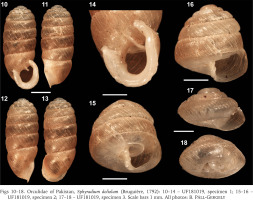
Bulimus doliolum Bruguière 1792: 351.
Sphyradium doliolum has been extensively cited in the literature due to its broad distribution, but synonyms are few; see Pilsbry (1922: 17–25, pl. 2, figs. 1, 2, 4; 1926: 256), Hausdorf (1996: 54–56, pl. 6, figs. 72–73), and Páll-Gergely et al. (2013: 41–42) for discussions.
Type specimens. unknown
Type locality. “environs de Paris”, [France]
Specimens examined. Pakistan, Khyber Pakhtunkhwa Province, 10 km N Kalam, Matiltan village, 3100m, 17 Sept. 1990, 35°10′N, 72°35′E, W. Auffenberg, et al., KA-784, UF 181019/42, mostly juveniles; UF 181020/1, in ethanol.
Description. Shell cylindrical (H: 5.5–5.7 mm, W: 2.3–2.4 mm W, n=2), apex dome-shaped with ca. 8 whorls, embryonic whorls spirally striated, sutures moderately to lightly impressed, penultimate whorl often more narrow than upper whorls, body whorl often flattened laterally behind lip; aperture auricular, often greatly thickened within, columella with two small lamellae, lower stronger, both entering more than one whorl, subequal in size inward, parietal lamella thin, erect, becoming lower toward apertural margin, extending inward over a whorl, becoming lower inward, increasing in height again near inward termination; parietal callus weak, thin; outer lip expanded, particularly basally and toward umbilicus, slightly reflexed, sinuous in lateral view, peripheral area extending further forward; shell often glossy, sculpture of prominent, oblique, axial ribs with periostracal ridges, often ragged, when fresh, juveniles with epidermal ridges terminating sharply just above suture; umbilicus rimate, partially covered by expanded lip; colour light brown, lighter around umbilicus and behind lip, apertural lip and columella whitish.
Distribution. Same as the genus. Specimens collected in these surveys from the northern Swat region, Khyber Pakhtunkhwa Province represent a new country record (Fig. 1).
Habitat. Mixed oak and cedar open forest, grassy; live specimens found under rocks at 3,100 m elevation. The specimens were collected with Deroceras laeve (O. F. Müller, 1774), Punctum sp., Euconulus sp., Hawaiia sp., and Truncatellina himalayana (Benson, 1863).
Comparative remarks. The species cannot be confused with other species in Pakistan due to its unique apertural barriers and internal lamella, domed apex, strong axial ribs, and distinct, ragged periostracum when present. Juveniles can be confused with Pyramidula species, but the former has a long parietal lamella, which distinguishes them from similarly shelled species.
Remarks. This Palearctic species was collected at only one site in the northern Swat region, but collecting activities were extremely limited in that area. The species was not found during more extensive collecting to the south and east.
Pyramidulidae Kennard & Woodward, 1914
Genus Pyramidula Fitzinger, 1833
Pyramidula Fitzinger 1833: 95.
Type species. Helix rupestris Draparnaud, 1801, by monotypy.
Distribution. The genus occurs from Western Europe east through Central and East Asia (Kerney et al. 1983, Egorov 2008, Sysoev & Schileyko 2009, Balashov & Gural-Sverlova 2011, Balashov 2016), Japan (Pilsbry & Hirase 1902), and Taiwan (Hwang 2015) and south with disjunct populations through Nepal (Pyramidula kuznetsovi Schileyko et Balashov, 2012), and the Indian Peninsula (P. euomphalus (Blanford et Blanford, 1861) (Raheem et al. 2014)) to the highlands of Sri Lanka (P. halyi (Jousseaume, 1894) (Naggs & Raheem 2000)); not recorded from the Philippines, Borneo, and mainland Southeast Asia. Gittenberger et al. (1980: 12) indicate that Pyramidula javana (Möllendorff, 1897) from Java, Bali, and Lombok, Indonesia needs to be revised as it may be related to Toltecia pusilla (Lowe, 1831) (= Paralaoma servilis (Shuttleworth, 1852)) (Punctidae).
Remarks. Recent studies on European populations of Pyramidula have provided critical data required to resolve their complex taxonomies (Gittenberger & Bank 1996, Martínez-Orti et al. 2007, Kirchner et al. 2016, Razkin et al. 2016a, b, Horsáková et al. 2022). The intensive morphologic and genetic studies have better defined these species that have high inter- and infra-specific shell variability. Study of Asiatic species may reveal similar morphologic and taxonomic trends. This variation, as well as a simple reproductive anatomy, makes identification difficult.
Three distinct morphotypes of Pyramidula were collected in Pakistan during the surveys discussed here. One is fairly confidently assigned to P. humilis (Benson, 1838) based solely on shell morphology. One is tentatively identified as P. cf. salimalii Rensch, 1955 (originally described as P. rupestris salimalii) and one species as Pyramidula sp. Although we believe populations with unique combinations of conchological characters may be primarily defined on the basis of shell morphology, we are reluctant to introduce new taxa at this time (see below for discussions). Two of the species discussed here appear to be limestone obligates, but the third appears not be so restricted. The scattered and often remote limestone regions of the western Himalaya, Pakistan, and Afghanistan may reveal undescribed species of Pyramidula with diversity similar to that found in Europe, i.e cryptic species.
In Pakistan Pyramidula species can be confused with Euconulus fulvus (O. F. Müller, 1774) (Euconulidae) and Kaliella nana (T. Hutton, 1838) (Helicarionidae), but the former is more broadly umbilicate, has distinct axial riblets, and fewer whorls.
Pyramidula humilis (Benson, 1838)
Figs 19–30
Pyramidulidae of Pakistan, Pyramidula humilis (Benson, 1838): 19–21 – UF197290, specimen 1; 22–24 – UF197290, specimen 2; 25–27 – UF197309; 28–30 – UF521533, specimen 1. Scale bars 1 mm. All photos: B. Páll-Gergely
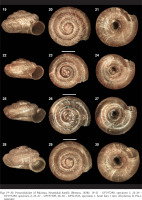
Helix humilis Benson 1838: 217.
Helix humilis Benson, 1838 – Pfeiffer 1847: 106; Reeve 1851: pl. 133, species 825; Pfeiffer 1853: 322–323, pl. 129, fig. 28; Hanley & Theobald 1873: 28, pl. 61, figs 4–6.
Helix (Patula) humilis Benson, 1838 – Pfeiffer 1856: 125; Albers & von Martens 1860: 86; Nevill 1878a: 66, Nevill 1878b: 18.
Vallonia humilis (Benson, 1838) – Theobald 1881: 49.
Patula (Discus) humilis (Benson, 1838) – Pfeiffer & Clessin 1881: 90.
Helix (Patula (Discus)) humilis Benson, 1838 – Tryon 1887: 22, pl. 3, figs 4–6.
Pyramidula humilis (Benson, 1838) – Pilsbry 1893: 44; Godwin-Austen 1899: 262; Gude 1914: 43; Auffenberg 1997: 258; Kuznetsov & Schileyko 1997: 135; Mitra et al. 2005: 129; Ramakrishna et al. 2010: 126; Preece et al. 2022: 157, fig. 70G.
Helix (Vallonia ?) humilis – Godwin-Austen 1914: 330, pl. 50, figs. 5 a, b (radula), pl. 158, fig. 1 (shell).
Type material. Lectotype (UMZC I.102010), designated by Preece et al. (2022): “Discus humilis Hutton.” from “Simla”).
Type locality. Simla [Shimla, Himachal Pradesh, India]
Material examined. Pakistan, Khyber Pakhtunkhwa Prov., 0.8 km S Khaira Gali, along road to Murree, 2,250 m, 33°58′48.0″N, 73°23′42.0″E, K. Auffenberg, 18 Sept. 1991, KA-988, UF 197309/1 (H: 2.0 mm, W: 3.8 mm), UF 197308 in alcohol; same data as preceding, UF 521533/17; Pakistan, Khyber Pakhtunkhwa Prov., Ayubia National Park, Dunga Gali, 2,340 m, 34°03′00.0″N, 73°25′01.2″E, 18 Sept. 1991, K. Auffenberg et al., KA-983–984, UF 197290/45.
Description. Shell light yellowish to greyish in colour throughout; size medium for genus (up to H: 2.6, W: 1.7 mm), depressed, somewhat glossy, 3.4–4.25 whorls, convex, increasing slowly in size, last 0.5 whorl descends regularly toward the aperture, sutures well-impressed, periphery rounded (usually) to slightly angulated, 1.1–1.25 nuclear whorls with spiral striations that fade near the teleoconch giving way to fine axial growth striations resulting in a silky surface; aperture roundish; parietal callus very weak or lacking, transparent; simple apertural lip, not reflected or thickened, fragile; umbilicus open and deep, ca. 1/2 width of base.
Habitat. “On moist rocks, on wet dead leaves, and at the roots of shrubs in the khads [valleys]” (Hutton & Benson 1838); “… on trees at Tandiani” (Theobald 1881). Found during these surveys on limestone boulders, in solution pits and in cracks and crevices, often aggregated, and among shaded litter and soil on conifer forest floor at 2,250–2,350 m in elevation. Specimens were found accompanied by Anadenus altivagus (Theobald, 1862), and Tanychlamys sp.
Comparative remarks. Pyramidula humilis can be distinguished from its congener, P. cf. salimalii (see below) by its lower shell and much broader umbilicus. Furthermore, P. cf. salimalii is darker (brownish instead of yellowish), has a glossier shell surface and less dense and less regularly arranged radial lines.
Distribution. Pyramidula humilis occurs in limestone regions of northwestern India (Hutton & Benson 1838, Hanley & Theobald 1876, Tryon 1887, Godwin-Austen 1899, Rensch 1955, Zilch 1962, Dey & Mitra 2000, Mitra et al. 2005) and the Galyat Range, Murree Hills, Pir Pangal Mountains of eastern central Pakistan (Nevill 1878b, Theobald 1881, Godwin-Austen 1899, Auffenberg 1997, this study, see Fig. 1). A single, dead specimen was reported from a grassy rockslide the Shivapuri-Nagarjun National Park, Kathmandu District, Nepal (Khanal & Budha 2013, Budha et al. 2015) and Kuznetsov & Schileyko (1997) report the species from Annapurna National Park in western Nepal.
Remarks. This species’ occurrence in such close proximity (ca. 4 km straight-line distance) to that of specimens assigned to Pyramidula cf. salimaii in Pakistan is interesting. Further collecting in the region is suggested.
The figure in Hanley & Theobald (1873, pl. 61, figs 4–6) depicts a specimen with a wider umbilicus than typical specimens of the species. We cannot explain this difference at this time.
The following footnote is included with the species’ description (Hutton & Benson 1838: 217): “A reversed variety of this shell occurs at Fágú, [18 km E Shimla, Himachal Pradesh] in decayed trees, differing thus in habits from the dextral species which affects rocks and dead leaves principally. The shell is of four whorls exclusive of apex, finely wrinkled by the lines of growth; umbilicus discovering the previous whorls. – Diameter 1½ lines [ca. 3.2 mm]. In all respects resembling the dextral shell.” A lot of four sinistral specimens from Jagoo [= Fágú] (leg: Capt. T. Hutton) is housed in the Natural History Museum (NHMUK 1856.9.15.45). Also, Nevill (1878b: 66) mentions a series of sinistral specimens in the Indian Museum collected by F. Stoliczka at “Chur, near Simla.” The status of these populations is unknown.
Pyramidula cf. salimalii Rensch, 1955
Figs 31–39
Pyramidulidae of Pakistan: 31–33 – Pyramidula cf. salimalii Rensch, 1955, UF181088, specimen 1; 34–36 – Pyramidula cf. salimalii UF181088, specimen 2; 37–39 – Pyramidula sp. UF197097, specimen 1. Scale bars 1 mm
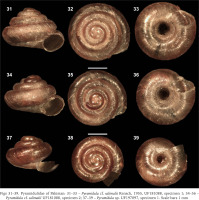
Pyramidula rupestris sálimalii Rensch 1955: 166.
Pyramidula rupestris salimalii – Zilch 1962: 232, pl. 7, fig. 7.
Types examined. Holotype: SMF 153481, Chakrata (Uttarakhand) – Deoband (Uttar Pradesh) area of northern India at ca. 8,000–10,000 ft. (ca. 2,450–3,050 m) above sea level (photographs in Rensch (1955) and Zilch (1962) examined). (Holotype and Paratypes: SMF 153494/15 not physically examined).
Additional specimens examined. Pakistan, Khyber Pakhtunkhwa Province, Nathia Gali, slope behind Green’s Hilltop Hotel, 2,480 m, 34°07′N, 73°22′E, K. Auffenberg et al., 16 Sept. 1991, KA-980, UF 197268/1 very small juvenile, identification questionable; Pakistan, Punjab Prov., Murree Hills, 2.0 km SW Murree, wooded stream, 2,000 m, 33°55′N, 73°24′E, K. Auffenberg et al., 20 Sept. 1990, KA-802, UF 181088/164, mostly subadults and juveniles; Pakistan, Punjab Prov., Murree Hills, N slope Murree Mt., 2.8 km E Sunny Banks, hiking trail to Kashmir Point, 2,050 m, 33°55′N, 73°24′E (in Khyber Pakhtunkhwa Prov. via Google Earth), K. Auffenberg et al., 20 Sept. 1991, KA-998, UF 197351/1.
Description of UF shells. Shell reddish brown to dark brown in colour throughout; size medium for genus (up to H: 2 mm × W: 2.7 mm), helicoid to depressed helicoid, 4.25–4.75 whorls, thin shelled, fragile, periphery bluntly angulated, 0.75–1.0 embryonic whorls, sutures well-impressed, last 0.75 whorl descends regularly toward aperture; aperture small, roundish (1.4 mm H, 1.4 mm W); parietal callus very weak or lacking; simple apertural lip, not reflected or thickened; umbilicus open and deep, ca. 1/3 width of base; shell sculpture of rather strong, somewhat regular axial growth wrinkles, often weaker on base, some striations with fine axial periostracal ridges along top.
Habitat. This species was collected alive in these surveys on shaded, mossy limestone boulders and oak tree trunks in mixed hardwood and conifer forests at elevations ranging from 2,000 to 2,480 m. Cylindrophaedusa waageni (Stoliczka, 1872), Tanychlamys spp., Bensonies monticola (Benson, 1838), Kaliella spp. and others accompanied this species.
Comparative remarks. Pyramidula humilis has a wider umbilicus, a lighter colour (rather greyish-yellowish, while this species is reddish brown) and a finer, silky sculpture (rather ribbed/wrinkled in this species), which is most prominent on the ventral side. Pyramidula kuznetsovi from Nepal often (not always) has a scalariform shell shape, has a much narrower umbilicus than this species, and has a finer sculpture, most prominently different on the ventral side.
Distribution. Known from Uttarakhand and Uttar Pradesh, northern India and from the two northeastern Pakistan localities mentioned above (Fig. 1). The distance between the two Pakistan populations is ca. 22 km.
Remarks. The type specimens were collected in association with P. humilis but are characterised by the more conoid shell (H: 2.0–2.5 mm, W: 2.5–2.9 mm), and narrower umbilicus (Rensch 1955: 166–167; Zilch 1962: 232, pl. 7, fig. 7).
We believe this taxon should be elevated to species level since it can be distinguished from Pyramidula humilis and a close relationship to the European P. rupestris is untenable. Although the UF material was collected ca. 550 km northwest of the type locality of P. salimalii, the key traits (conical shell, relatively narrow umbilicus, wrinkled shell surface) are similar. Therefore, the UF shells are provisionally identified here as P. cf. salimalii.
Pyramidula sp.
Material examined. Pakistan, Khyber Pakhtunkhwa Prov., 36.8 SW Karimabad, stream on N side of Rakaposhi Mountain, just W Kasimabad village, 2,000 m, 36°15′N, 74°31′E, K. Auffenberg, et al., KA-928, UF 197097/1 fragment.
Remarks. This single, broken shell has a very narrow umbilicus. Its colour and sculpture is most similar to Pyramidula cf. salimalii, but the latter species has a slight keel on the body whorl. Pyramidula kuznetsovi has a similar narrow umbilicus, but most specimens are keeled and higher spired. This may be a new species, but the material is insufficient for description. This was the only Pyramidula found in these surveys in a non-limestone area (Fig. 1). This specimen was accompanied by numerous species, including Pupilla satparanica Pokryszko et Auffenberg, 2009, P. annandalei Pilsbry, 1921, Gastrocopta huttoniana (Benson, 1849), Vallonia ladacensis (G. Nevill, 1878) and others.
DISCUSSION
The Pupilloidea is the most diverse group of terrestrial mollusks in Pakistan. Pokryszko et al. (2009) studied several genera, providing locality records, habitats, and the description of ten new species. The fauna is most greatly influenced at the genus level by the Palearctic/Holarctic, not the western Indomalayan Realm of Udvardy (1975).
South-central Asia is one of the most biologically diverse regions of the world. Yet, most of this vast mountainous area remains inadequately surveyed for terrestrial mollusks due to its harsh terrain, periodic political unrest, as well as a general lack of trained malacologists. The land snail surveys made in Pakistan during 1990–1992 make clear that further collecting activity is required and suggests that many more species remain to be collected and described.

